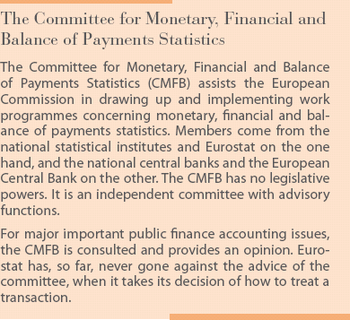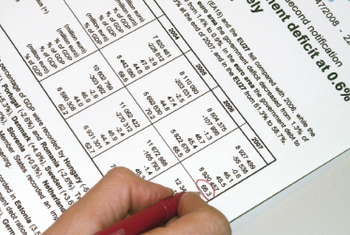Archive:Eurostat - Watchdog of European public finances
This Statistics Explained article is outdated and has been archived - for recent articles on government statistics see here.
- Published in Sigma - The Bulletin of European Statistics, 2008/03

Have you ever heard about the Excessive deficit procedure? The Maastricht criteria? Wondered why these criteria are important? Have you thought about how the European Union (EU) keeps track of each Member State? Ensures everyone follows the same rules? Sigma met Luca Ascoli, Head of Eurostat’s Public Finance Unit, and Lena Frej Ohlsson, Statistical Officer in the same unit, to find out more about government finance statistics.
Introduction
Government finance statistics are crucial to the European Union, as they are used to determine whether a country’s government debt and deficit are within certain limits linked to the stability of the euro currency.
EU countries are obliged to avoid excessive public finance deficits according to the Stability and growth pact. According to the Maastricht criteria, the public deficit should be less than 3 % of GDP and the debt less than 60 % of GDP. If a country reports a bigger deficit than allowed, the European Commission publishes a report and can recommend the Economic and Financial Affairs Council (Ecofin) to start an Excessive deficit procedure. At the same time the Council recommends corrective actions to be undertaken within a certain time-frame. If the country still does not come to terms with the excessive deficit, the Council can oblige the country to undertake the actions and in the end the country can be fined. The rules apply both to the EU and euro Member States; however, only euro area countries can be fined.
The Ecofin Council suspends the Excessive deficit procedure when it judges that the excessive deficit has been corrected.
Eurostat keeps watch
In the EU, Eurostat is in charge of receiving, assessing and publishing government finance statistics submitted by the Member States, as well as ensuring that everyone follows the rules. The keystone for this work is the European system of national and regional accounts (ESA 95), which lays down the concepts and definitions for government finance statistics as well as other national accounts data. However, since ESA 95 is too general in some areas of government finance, Eurostat has published a manual —Manual on government deficit and debt — which provides more detailed information on how the rules in ESA 95 should be interpreted. Over the years the manual has been complemented with chapters on new issues, such as the classification of pension schemes and how they impact on government finance.
If Mr Ascoli and his colleagues discover that there is room for interpretation in an area and that a number of Member States are classifying a transaction in different ways, they can establish an ad hoc taskforce on a specific issue. It is chaired by Eurostat and consists of experts from the Member States, the European Central Bank and the European Commission’s Directorate-General for Economic and Financial Affairs. Before Eurostat adopts a decision on the issue, the Committee for Monetary, Financial and Balance of Payments Statistics (CMFB) may be consulted. When major new decisions, such as how to record public–private partnerships, are adopted, they eventually become new chapters of the manual, which are published on Eurostat’s website.
Reservations and amendments
In theory, Member States are not legally bound to follow the rules in the Manual on government deficit and debt, as it is not an EU regulation. But, in recent years, case-law suggests that they should. In fact, three of Eurostat’s decisions were challenged at the Court of Justice of the European Communities in 2007 and 2008, and in all cases Eurostat did not have to review its original decision.
Moreover, political pressure to comply is high. If Eurostat doubts the quality of the reported data it publishes ‘reservations’ in its press release. Eurostat may also in specific cases amend data reported by the Members States when the data do not comply with accounting rules.
‘The reservations and amendments are published at the same time as the data are made public — in April and October. We also work closely with the country to solve the issue bilaterally. At the end of the day it is an efficient procedure and through cooperation countries usually comply with Eurostat rules or advice,’ said Mr Ascoli.
Road tolls and vignettes
Eurostat also has other means of clarifying the recording of different types of transactions, either on its own initiative or at the request of a Member State. Eurostat provides guidance notes on issues which are less complex and involve fewer Member States. This was, for example, the case for road tolls and vignettes. Tolls are mainly paid in proportion to the number of kilometres the car will travel, and vignette payments are designed for a predetermined time, such as a week or a year. The issue was whether the revenue from the tolls and sales of vignettes should be classified as sales of a service or as a tax.
‘After analysing the subject and discussing it with the Financial Accounting Working Group where all Member States are represented, Eurostat issued a guidance note which says that tolls should be classified as a sale of a service. If the driver has sufficient choice both in terms of road selection and the duration of the vignette, this revenue should also be classified as a sale of a service,’ said Ms Frej Ohlsson.
‘All Member States have confirmed that they will follow this guidance note,’ she continued.
Furthermore, since 2006 all Member States can consult Eurostat officially on how to classify a transaction in a specific case. Methodological advice may be given for transactions which are already undertaken, or for transactions which are planned.
‘As for all our decisions and guidance notes, we also publish the methodological advice we give to Member States, if they agree, on Eurostat’s website,’ said Ms Frej Ohlsson.

Country desks and missions
To further ensure that all Member States follow the rules, Eurostat has established country desks, where Mr Ascoli’s team members keep a close eye on ‘their’ Member States. The Desk Officers also go on specific country missions together with representatives from the ECB and the Economic and Financial Affairs DG at least every second year. There they meet officials who work with government finance statistics, armed with questionnaires and inventories, in order to review in detail data and methodological issues.
‘A typical country mission aims, among other things, to discuss the quality and exhaustiveness of primary data sources and to review the progress achieved in implementing ESA 95 methodology. We also want to assure that provisions from the Manual on government deficit and debt and recent Eurostat decisions are followed,’ explained Ms Frej Ohlsson.
After each mission Eurostat publishes a report, which is available on Eurostat’s website.
Building up capacity
In 2005, the Economic and Finance Ministers called for more resources to be allocated to the follow-up of the government finance statistics both at Commission level and in the Member States. This was due to the opening of Excessive deficit procedures for Portugal, Germany and France in 2002 and 2003 and the accession of the 10 new Member States in 2004 — several of them reporting excessive deficits. It was furthermore linked to the revision of the Stability and Growth Pact in 2005, as well as major revisions of data in countries such as Greece.
‘During the last few years we have built up both the legislative framework and Eurostat’s capacity to help Member States on methodological issues. We also aim to publish a revised version of the Manual on government deficit and debt in the middle of 2009. The goal is to enhance the presentation, ensure that there are no contradictions and inconsistencies as well as to integrate the new chapters,’ said Mr Ascoli.

